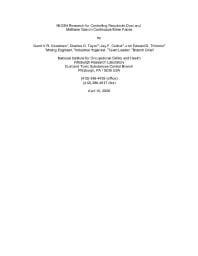Mining Publication: NIOSH Research for Controlling Respirable Dust and Methane Gas on Continuous Miner Faces
Original creation date: September 2000
Authors: GV Goodman, CD Taylor, JF Colinet, ED Thimons
NIOSHTIC2 Number: 20024719
Proc 12th International Conference on Coal Research, Sandton, Republic of South Africa. Johannesburg, South Africa: South Africa Institute of Mining and Metallurgy 2000 Sep; :151-154
The importance of controlling respirable dust and methane gas levels in underground coal mining cannot be underestimated. While respirable dust can significantly affect the occupational health of underground coal miners, methane gas accumulations pose significant safety concerns for these same workers. Water sprays and machine mounted dust scrubbers offer effective control of respirable dust exposures and methane gas accumulations. Water must not only be applied carefully to avoid dust rollback to the machine operator but must create sufficient turbulence to remove dead zones that could contain high concentrations of methane gas. While the flooded-bed dust scrubber has been generally responsible for decreased worker exposures to respirable dusts, this device has proved effective in controlling methane levels at the face. This paper reviews practical applications of water sprays and dust scrubbers to control respirable dust and methane gas on continuous miner faces.

NIOSHTIC2 Number: 20024719
Proc 12th International Conference on Coal Research, Sandton, Republic of South Africa. Johannesburg, South Africa: South Africa Institute of Mining and Metallurgy 2000 Sep; :151-154
- Continuous Miner Spray Considerations for Optimizing Scrubber Performance in Exhaust Ventilation Systems
- Development and Application of Reservoir Models and Artificial Neural Networks for Optimizing Ventilation Air Requirements in Development Mining of Coal Seams
- The Effects of Water Spray Placement for Controlling Respirable Dust and Face Methane Concentrations
- Emerging Technologies Control Respirable Dust Exposures for Continuous Mining and Roof Bolting Personnel
- Engineering Considerations and Selection Criteria for Proximity Warning Systems for Mining Operations
- Evaluation of the Relative Importance of Coalbed Reservoir Parameters for Prediction of Methane Inflow Rates During Mining of Longwall Development Entries
- Guidelines for the Control and Monitoring of Methane Gas on Continuous Mining Operations
- NIOSH Research in Coal Dust and Explosions
- Remote Methane Sensors
- Respirable Dust Control Methods on Continuous Mining Operations